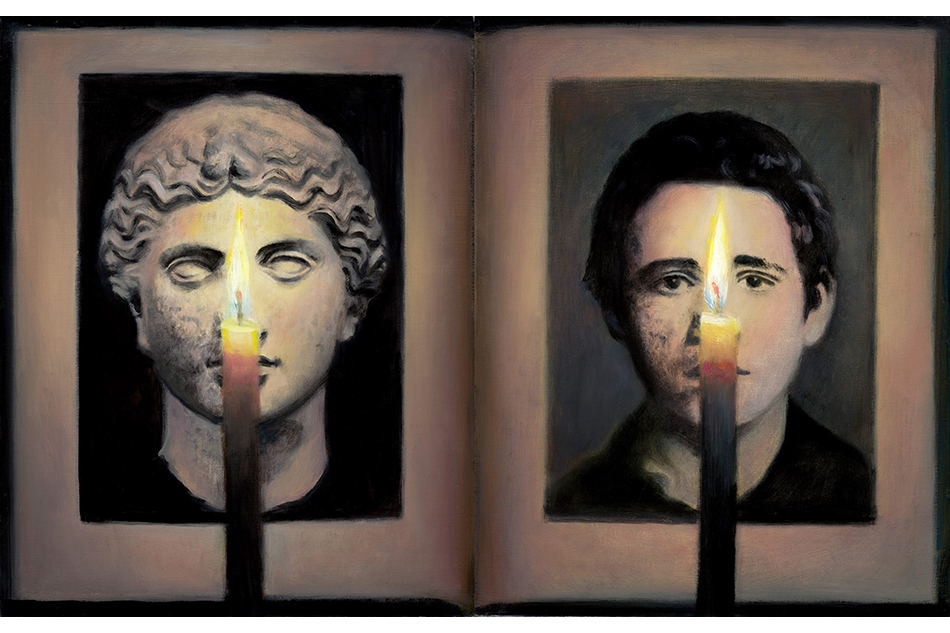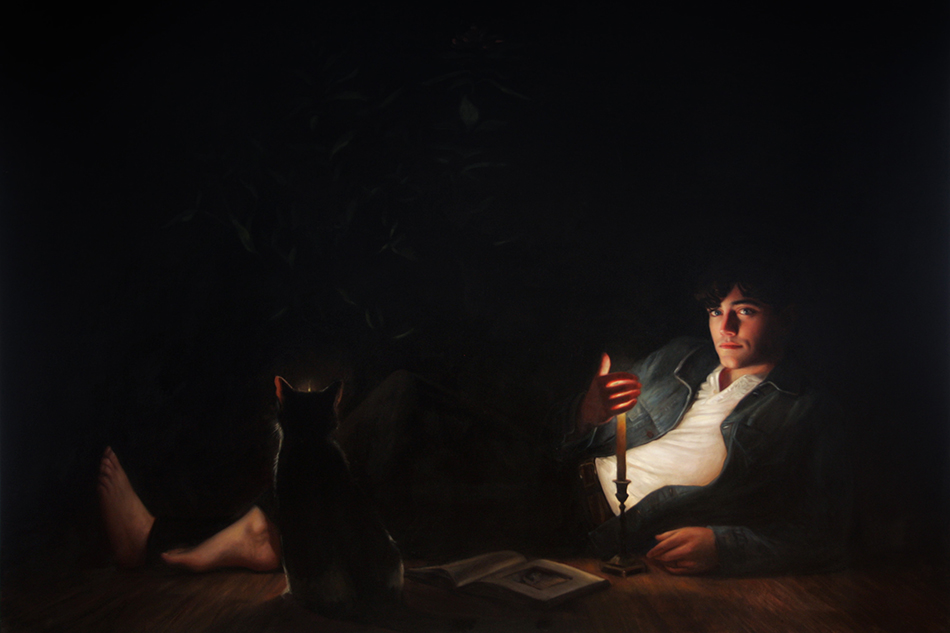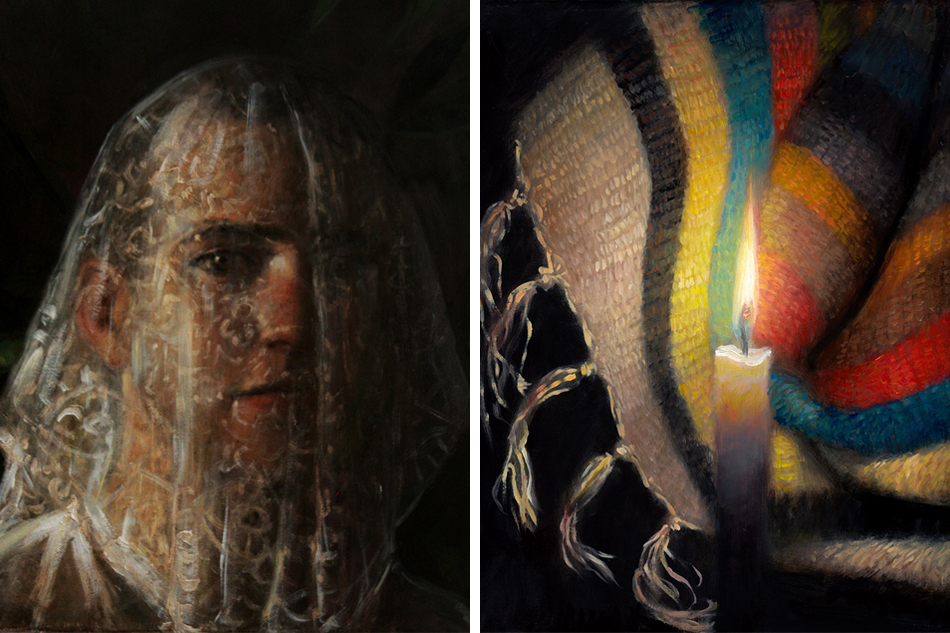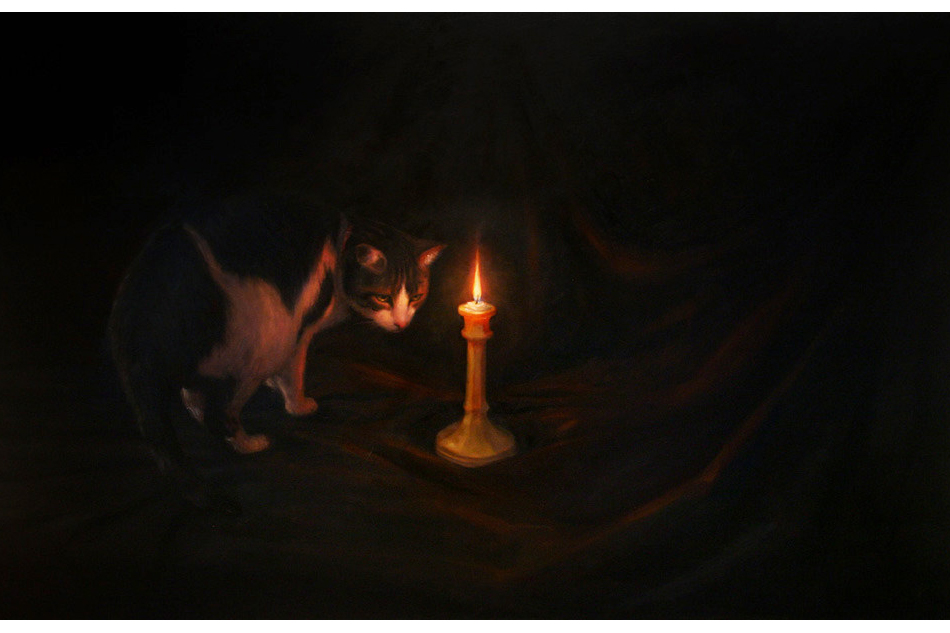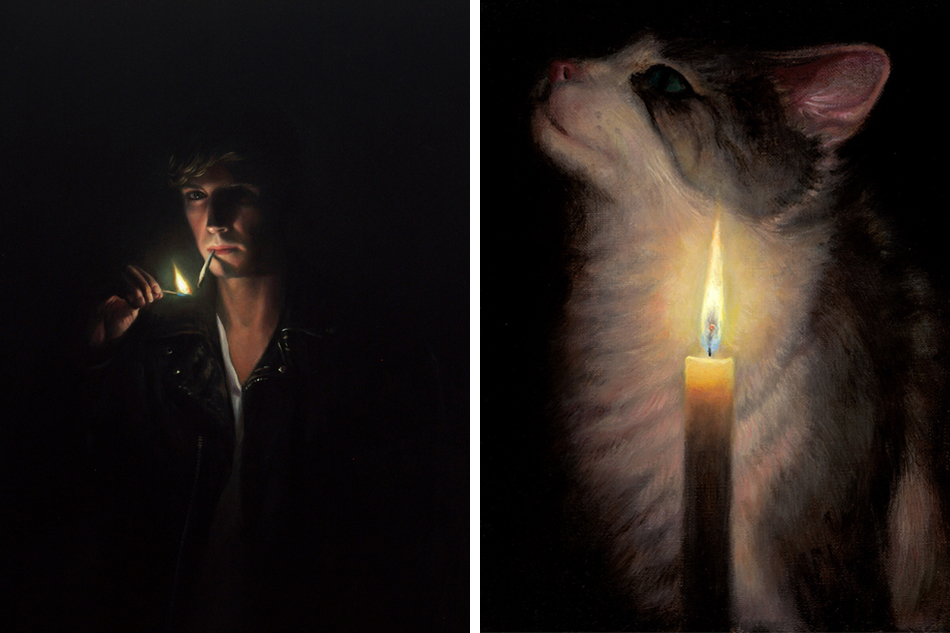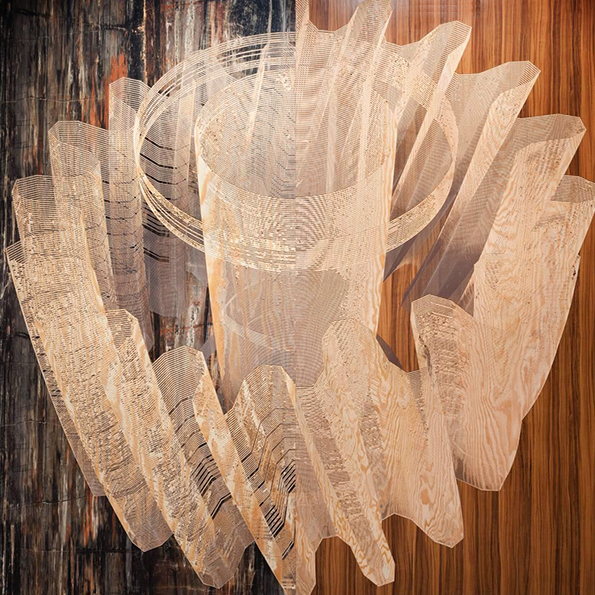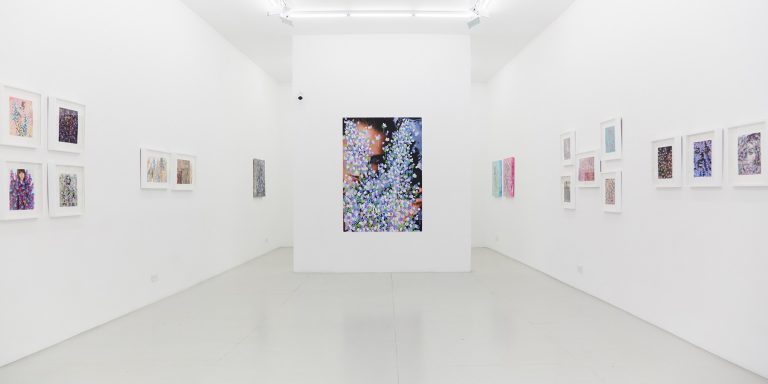
December 4, 2013Candle-lit oil-on-canvas works by T.M. Davy, including Candela (Sleep), 2013, are now on view at Eleven Rivington on New York’s Lower East Side. All images courtesy of the artist and Eleven Rivington
The artist T.M. Davy is standing in the middle of his Bushwick loft, showing off his most recent work, now on view (through January 5, 2014) in “Candela,” his second solo show at Eleven Rivington, on New York’s Lower East Side. Behind him on the wall hangs a long row of small dark oil paintings, each depicting a friend or an object from his own household lit by a single candle flame.
In one picture, the flame illuminates the hairy chest of Liam, the artist’s husband of two years; in another it glows gold and blue from behind a cream-colored piece of lace given to the couple by a great aunt. In a third, the flame is almost completely concealed by a pressed-glass goblet, whose facets refract the light into a carefully calibrated cascade of tiny rainbows.
But the most mind-bending painting has to be the one in which a candle illuminates a bluish-gray seascape made by the artist’s father, who happens to be the chief muralist for the New York decorative painting company EverGreene Architectural Arts. “My dad does paintings of waves on Long Island,” Davy explains. “My work is about spending time with domestic space, and his is about spending time with nature.” The background of his father’s painting is brushily rendered, and Davy’s candle is, too — as if to suggest that its tiny flame is lighting up the whole of the painted universe.

Candela (Red), 2013
In fact, Davy regards candles as something of an emblem for all light, having studied them for hours and hours in the darkened storage room where he sets up his still lifes. (He props his canvas on an easel just on the other side of the door.) “The candle is technically a full spectrum light, with all color contained in it, he says. “At the bottom of the flame, where it’s burning, the flame gets blue. As it hits the air, it creates yellows and reds. And that’s been in art forever — this idea of blue, yellow, red, or the rainbow.”
Now 33, Davy has been painting candles in one way or another for several years. At Basel’s Liste fair in 2012, he showed large candlelit portraits in the booth of his Berlin gallery, Exile. Then, his primary focus was the figure, rendered in the style of the Dutch masters. But about a year ago, he says, “I started putting the candle in the middle of the picture and thinking about the ways in which the light falls away from it,” with the result that the new works are “somehow as much about the light as they are about the object.”
Twelve of these pieces (all named Candela, after a single unit of luminous intensity) were shown by Eleven Rivington at the 2013 Armory Show. According to Augusto Arbizo, the gallery’s director, the booth attracted a huge amount of attention for someone who “is still very much an emerging artist” and sold out, along with every other “Candela” painting the gallery had on hand. Arbizo recalls being impressed by Davy’s technical facility and thoughtfulness when he first visited the studio five years ago. “T.M. values studying, long looking and contemplation,” he says. “His paintings aren’t just one-offs. That’s different from how most artists are working today.”

To create his paintings, Davy sets up his subject in a darkened room and then works at an easel just beyond the the room’s door.
Though the artist can make other kinds of paintings, Abrizo says he respects the fact that Davy has decided to focus on the candles for now, which the gallerist considers especially impressive. “He has really honed in on the idea of light and all its various symbolisms — how it essentially makes a painting, how it transforms an object or a face or a figure, how much is required for you to make out an image.”
Those paintings really show an enormous amount of virtuosity,” says another supporter, the artist and curator A.A. Bronson. “They are incredibly difficult to make.” Bronson included a candlelit portrait of himself by Davy in his own show, “The Temptation of A.A. Bronson,” on view through January 5, 2014, at Witte de With Contemporary Art, in Rotterdam, the Netherlands. (As director of the Institute for Art, Religion and Social Justice at New York’s Union Theological Seminary, a program designed to reinvigorate the relationship between religion and art, Bronson commissioned Davy to paint the prominent theologian and longtime faculty member Christopher Morse.)
Davy’s fascination with representational painting began during his childhood on Long Island. By age 12 he was obsessed with Caravaggio, whose renderings of figures and light, he says, “still kind of stay in the center of my soul.” By high school, he was working part-time in EverGreene’s mural shop. Eager to focus on figurative painting, he studied illustration at the School of Visual Arts but found himself foundering after graduation.

The paintings in this “Candela” series, says Davy, seen here at home, are “somehow as much about the light as they are about the object.”
Things started to coalesce in 2006, around the time he began modeling for the painter Ellen Altfest, sitting for two paintings (one of his penis, the other of his naked torso) over the course of 18 months. The two became close friends, visiting shows together and “intensely discussing anything to do with representation,” Altfest says. Up to this time, Davy had been making symbol-laden portraits of women and effeminate-looking boys that recalled the pre-Raphaelites. But now he began to create frankly sensual paintings of men against dark backgrounds — as in a 2007 work that re-envisioned the performance artist Kalup Linzy as Manet’s Olympia.
“He was definitely interested in flames, and also in portraiture and sexy men,” Altfest recalls. “That’s when he made the leap into the work he’s making now.”
Another change in Davy’s work came in the summer of 2012, after he met Bronson during a residency with the public-art nonprofit BOFFO on Fire Island and began sketching his portrait. “I was immediately struck by how skilled he was,” Bronson says. He suggested that Davy render him as Olympia, too — an idea that the artist took to with alacrity, first posing Bronson by candlelight in the Enchanted Forest (a wooded cruising ground between the Pines and Cherry Grove) and later in his studio. During that time, the “Candela” series emerged.
“The paintings of the candles are extremely intimate,” says Bronson, “and that’s the feeling that you get from the portraits, too.”
But for Davy, every painting is “an excuse to spend time with people or to think about things that are already in my life,” he says. And “even when it seems to be about the thing,” he adds, “it’s always about something else.”

